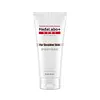What's inside
What's inside
 Key Ingredients
Key Ingredients

 Benefits
Benefits

 Concerns
Concerns

 Ingredients Side-by-side
Ingredients Side-by-side

Water
Skin ConditioningSodium Lauroamphoacetate
CleansingSodium Methyl Cocoyl Taurate
CleansingSodium Chloride
MaskingCocamidopropyl Betaine
CleansingSodium Cocoamphoacetate
CleansingHydroxypropyl Starch Phosphate
Citric Acid
BufferingStyrene/Acrylates Copolymer
Acrylates Copolymer
Glycerin
HumectantPhenoxyethanol
PreservativePotassium Hydroxide
BufferingChlorphenesin
AntimicrobialDisodium EDTA
Butylene Glycol
HumectantTranexamic Acid
AstringentSodium Hyaluronate
HumectantHydrolyzed Collagen
EmollientDipotassium Glycyrrhizate
HumectantAlpha-Glucan Oligosaccharide
CleansingPanax Ginseng Root Extract
EmollientHouttuynia Cordata Extract
Skin ConditioningGinkgo Biloba Leaf Extract
Skin ConditioningVaccinium Myrtillus Leaf Extract
AstringentWater, Sodium Lauroamphoacetate, Sodium Methyl Cocoyl Taurate, Sodium Chloride, Cocamidopropyl Betaine, Sodium Cocoamphoacetate, Hydroxypropyl Starch Phosphate, Citric Acid, Styrene/Acrylates Copolymer, Acrylates Copolymer, Glycerin, Phenoxyethanol, Potassium Hydroxide, Chlorphenesin, Disodium EDTA, Butylene Glycol, Tranexamic Acid, Sodium Hyaluronate, Hydrolyzed Collagen, Dipotassium Glycyrrhizate, Alpha-Glucan Oligosaccharide, Panax Ginseng Root Extract, Houttuynia Cordata Extract, Ginkgo Biloba Leaf Extract, Vaccinium Myrtillus Leaf Extract
Water
Skin ConditioningSodium Cocoyl Isethionate
CleansingC12-15 Alkyl Benzoate
AntimicrobialSodium Lauroamphoacetate
CleansingSodium Methyl Cocoyl Taurate
CleansingCoco-Glucoside
CleansingDecyl Glucoside
CleansingGlycerin
HumectantGlycol Distearate
EmollientAcrylates/Beheneth-25 Methacrylate Copolymer
Methyl Glucose Caprate/Caprylate/Oleate
EmollientBenzyl Alcohol
PerfumingSodium Hydroxide
BufferingPropanediol
SolventSodium Hyaluronate
HumectantCamellia Sinensis Leaf Extract
AntimicrobialMethylisothiazolinone
PreservativeDehydroacetic Acid
PreservativeCitric Acid
BufferingLactococcus Ferment Lysate
Skin ConditioningVitis Vinifera Seed Extract
AntimicrobialInulin
Skin ConditioningYogurt Powder
Lactic Acid
BufferingSodium Chloride
MaskingSodium Benzoate
MaskingChlorophyllin-Copper Complex
AntioxidantWater, Sodium Cocoyl Isethionate, C12-15 Alkyl Benzoate, Sodium Lauroamphoacetate, Sodium Methyl Cocoyl Taurate, Coco-Glucoside, Decyl Glucoside, Glycerin, Glycol Distearate, Acrylates/Beheneth-25 Methacrylate Copolymer, Methyl Glucose Caprate/Caprylate/Oleate, Benzyl Alcohol, Sodium Hydroxide, Propanediol, Sodium Hyaluronate, Camellia Sinensis Leaf Extract, Methylisothiazolinone, Dehydroacetic Acid, Citric Acid, Lactococcus Ferment Lysate, Vitis Vinifera Seed Extract, Inulin, Yogurt Powder, Lactic Acid, Sodium Chloride, Sodium Benzoate, Chlorophyllin-Copper Complex
 Reviews
Reviews

Ingredients Explained
These ingredients are found in both products.
Ingredients higher up in an ingredient list are typically present in a larger amount.
Citric Acid is an alpha hydroxy acid (AHA) naturally found in citrus fruits like oranges, lemons, and limes.
Like other AHAs, citric acid can exfoliate skin by breaking down the bonds that hold dead skin cells together. This helps reveal smoother and brighter skin underneath.
However, this exfoliating effect only happens at high concentrations (20%) which can be hard to find in cosmetic products.
Due to this, citric acid is usually included in small amounts as a pH adjuster. This helps keep products slightly more acidic and compatible with skin's natural pH.
In skincare formulas, citric acid can:
While it can provide some skin benefits, research shows lactic acid and glycolic acid are generally more effective and less irritating exfoliants.
Most citric acid used in skincare today is made by fermenting sugars (usually from molasses). This synthetic version is identical to the natural citrus form but easier to stabilize and use in formulations.
Read more about some other popular AHA's here:
Learn more about Citric AcidGlycerin is already naturally found in your skin. It helps moisturize and protect your skin.
A study from 2016 found glycerin to be more effective as a humectant than AHAs and hyaluronic acid.
As a humectant, it helps the skin stay hydrated by pulling moisture to your skin. The low molecular weight of glycerin allows it to pull moisture into the deeper layers of your skin.
Hydrated skin improves your skin barrier; Your skin barrier helps protect against irritants and bacteria.
Glycerin has also been found to have antimicrobial and antiviral properties. Due to these properties, glycerin is often used in wound and burn treatments.
In cosmetics, glycerin is usually derived from plants such as soybean or palm. However, it can also be sourced from animals, such as tallow or animal fat.
This ingredient is organic, colorless, odorless, and non-toxic.
Glycerin is the name for this ingredient in American English. British English uses Glycerol/Glycerine.
Learn more about GlycerinChances are, you eat sodium chloride every day. Sodium Chloride is also known as table salt.
This ingredient has many purposes in skincare: thickener, emulsifier, and exfoliator.
You'll most likely find this ingredient in cleansers where it is used to create a gel-like texture. As an emulsifier, it also prevents ingredients from separating.
There is much debate on whether this ingredient is comedogenic. The short answer - comedogenic ratings don't tell the whole story. Learn more about comegodenic ratings here.
The concensus about this ingredient causing acne seems to be divided. Research is needed to understand if this ingredient does cause acne.
Scrubs may use salt as the primary exfoliating ingredient.
Learn more about Sodium ChlorideSodium Hyaluronate is hyaluronic acid's salt form. It is commonly derived from the sodium salt of hyaluronic acid.
Like hyaluronic acid, it is great at holding water and acts as a humectant. This makes it a great skin hydrating ingredient.
Sodium Hyaluronate is naturally occurring in our bodies and is mostly found in eye fluid and joints.
These are some other common types of Hyaluronic Acid:
Learn more about Sodium HyaluronateWe don't have a description for Sodium Lauroamphoacetate yet.
This gentle cleansing and foaming ingredient is known for leaving a smooth feeling in skin and hair. It is made using coconut oil.
According to the manufacturer, it is soluble in water and has resistance to hard water, acid, and alkali.
Due to its coconut base, it may not be Malassezia folliculitis safe.
Learn more about Sodium Methyl Cocoyl TaurateWater. It's the most common cosmetic ingredient of all. You'll usually see it at the top of ingredient lists, meaning that it makes up the largest part of the product.
So why is it so popular? Water most often acts as a solvent - this means that it helps dissolve other ingredients into the formulation.
You'll also recognize water as that liquid we all need to stay alive. If you see this, drink a glass of water. Stay hydrated!
Learn more about Water